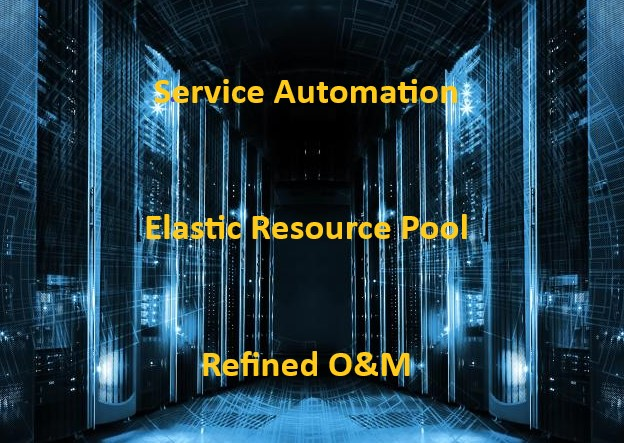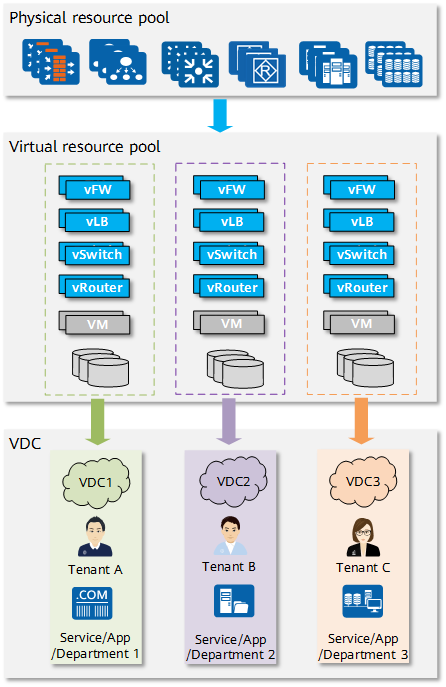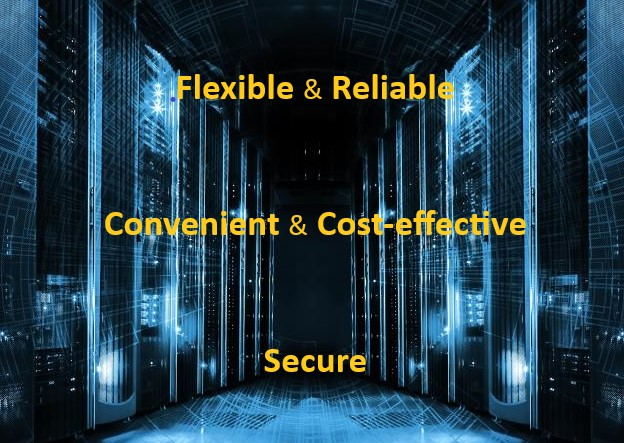What Is VDC?
A VDC is a new type of DC that leverages cloud computing. It is a resource container and provides quota management for compute, storage, and network resources. Users can manage and provision services to a VDC through a cloud platform.
Why Do We Need VDC?
With the acceleration of digitalization, the network architecture and service capabilities of traditional DCs are facing many challenges and difficulties.
Network architecture: Traffic in a DC is facing new trends, such as centralized switching data and explosive east-west traffic growth. These new trends pose the following requirements on the data center network: large scale, high scalability, enhanced robustness, low configuration costs, high bandwidths between servers, efficient network protocols, flexible topology and link capacity control, energy conservation, traffic isolation between services, and low costs. These requirements are beyond the reach of a traditional data center network that uses the three-layer architecture. A flattened, virtualized, programmable, and definable network architecture becomes a new trend of data center network development.
Service capabilities: First, the service deployment efficiency of a traditional DC is low. Before new services are provisioned, a lot of planning, configurations, testing and evaluation of impacts on existing services need to be completed. The long deployment period cannot match needs of new services. In addition, resources are not efficiently utilized. Many systems need to exclusively occupy resource pools, leading to siloed resource pools. When a system consumes only a few resources in a resource pool, other systems cannot consume the remaining resources in that resource pool. Finally, O&M management is complicated. Diverse services are running in a DC. It is difficult to detect and isolate faults rapidly if a certain service fails.
To adapt to the new trends and solve the service difficulties of traditional DCs, a VDC uses VXLAN and SDN technologies and works with the cloud platform to implement adaptation and association between networks and services. Such a cloud-based DC can improve resource utilization and service provisioning efficiency.
VDC Characteristics
Automated services, elastic resource pools, and refined O&M are three typical characteristics of VDCs, which help address the problems in traditional DCs. A traditional DC is constructed by adding more compute, storage, and network resources. On the contrast, a VDC adopts virtualization technology, which virtualizes a single physical server into multiple virtual machines (VMs). In a VDC, all infrastructures are virtualized, and hardware configurations are automated by the intelligent software system. This is the biggest difference between traditional DCs and VDCs, and is also one of the outstanding advantages of VDCs.

Three Characteristics of VDC
Software-defined computing (virtual servers) and software-defined storage (distributed storage) have been supported at present. To implement agile networks, software-defined networks (SDNs) must be built.

VDC concept
The VDC technology allocates resources to different applications to avoid resource conflicts.
VDC Advantages
VDCs have the following advantages over traditional DCs:
- Flexible and reliable: Virtualization and automatic deployment technologies are used to build a scalable and virtualized architecture. Infrastructure is provided as services and physical resources are integrated to enhance service capabilities. Resources are dynamically allocated and scheduled to improve resource utilization and service reliability.
- Convenient and cost-effective: A unified and innovative operation management system is constructed for a VDC. The system adopts the centralized management and distributed service pattern to provide users with network-wide basic IT infrastructure solutions and services when users' applications are handled at one site. Automatic service provisioning capabilities are provided, reducing O&M costs and enhancing user experience. For example, heat dissipation, physical server deployment, data backup, and testing in a traditional DC cause high routine management and maintenance costs. In contrast, virtual servers in a VDC use less physical hardware and generate less heat. In addition, software-based management simplifies data backup. This helps reduce O&M costs.
- Secure: More security and reliability mechanisms are provided to meet the security standards of enterprise-level applications.

Three advantages of a VDC
- Author: Yang Xuechen
- Updated on: 2023-06-06
- Views: 2269
- Average rating:






